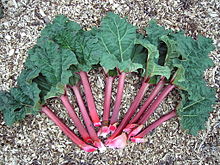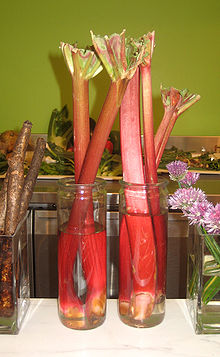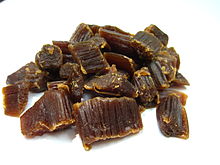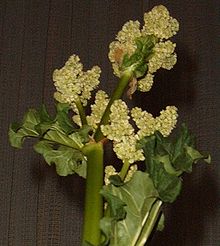- Rhubarb
-
For other uses, see Rhubarb (disambiguation).
Rhubarb 
Scientific classification Kingdom: Plantae (unranked): Angiosperms (unranked): Eudicots (unranked): Core eudicots Order: Caryophyllales Family: Polygonaceae Genus: Rheum Species: R. rhabarbarum Binomial name Rheum rhabarbarum
L.Rhubarb is a group of plants that belong to the genus Rheum in the family Polygonaceae. They are herbaceous perennial plants growing from short, thick rhizomes. They have large leaves that are somewhat triangular-shaped with long fleshy petioles. They have small flowers grouped in large compound leafy greenish-white to rose-red inflorescences.
Although the leaves are toxic, various parts of the plants have medicinal and culinary uses. The traditional Chinese pharmacopeia features rhubarb (as a laxative).[1] In culinary use, fresh raw stalks are crisp (similar to celery) with a strong tart taste; most commonly the plant's stalks are cooked and used in pies and other foods for their tart flavour. A number of varieties have been domesticated for human consumption, most of which are recognised as Rheum x hybridum by the Royal Horticultural Society.
Rhubarb is usually considered to be a vegetable; however, in the United States, a New York court decided in 1947 that since it was used in the United States as a fruit, it was to be counted as a fruit for the purposes of regulations and duties. A side effect was a reduction in taxes paid.[2]
Contents
Cultivation
Rhubarb, raw
(Rheum rhabarbarum)Nutritional value per 100 g (3.5 oz) Energy 88 kJ (21 kcal) Carbohydrates 4.54 g - Sugars 1.1 g - Dietary fibre 1.8 g Fat 0.2 g Protein 0.9 g Water 93.61 g Folate (vit. B9) 7 μg (2%) Vitamin C 8 mg (10%) Vitamin E 0.27 mg (2%) Vitamin K 29.3 μg (28%) Calcium 86 mg (9%) Iron 0.22 mg (2%) Potassium 288 mg (6%) Sodium 4 mg (0%) Zinc 0.1 mg (1%) Percentages are relative to US recommendations for adults.
Source: USDA Nutrient DatabaseRhubarb is now grown in many areas and, thanks to greenhouse production, is available throughout much of the year. Rhubarb grown in hothouses (heated greenhouses) is called hothouse rhubarb and is typically made available at consumer markets in early spring, before outdoor cultivated rhubarb is available. Hothouse rhubarb is usually brighter red, more tender and sweeter-tasting than cultivated rhubarb.[3] In temperate climates, rhubarb is one of the first food plants to be ready for harvest, usually in mid- to late spring (April/May in the northern hemisphere, October/November in the southern hemisphere), and the season for field-grown plants lasts until September. In the northwestern US states of Oregon and Washington, there are typically two harvests: one from late April to May and another from late June into July. Rhubarb is ready to be consumed as soon as it is harvested, and freshly cut stalks will be firm and glossy.
In the United Kingdom, the first rhubarb of the year is harvested by candlelight in forcing sheds - where all other light is excluded; the sheds are dotted around the noted "Rhubarb Triangle" of Wakefield, Leeds, and Morley,[4] a practice that produces a sweeter, more tender stalk.[5]
Rhubarb will grow year-round in warm climates, but in temperate climates, the aboveground portion of the plant completely withers away at the onset of freezing temperature; the plant grows from the root at the return of warm weather. Rhubarb growth can be forced or encouraged to grow early by raising the local temperature, usually by placing an upturned bucket over the new shoots. Because rhubarb is a seasonal plant, obtaining fresh rhubarb out of season is difficult in colder climates, such as in the UK.
Rhubarb can successfully be planted in containers, so long as the container is large enough to accommodate a season's growth.
The colour of rhubarb stalks can vary from the commonly associated crimson red, through speckled light pink, to simply light green. Rhubarb stalks are poetically described as crimson stalks. The colour results from the presence of anthocyanins, and varies according to both rhubarb variety and production technique. The colour is not related to its suitability for cooking:[6] The green-stalked rhubarb is more robust and has a higher yield, but the red-coloured stalks are much more popular with consumers.[citation needed]
Historical cultivation
Rhubarb has been used for medical purposes by the Chinese for thousands of years and appears in The Divine Farmer's Herb-Root Classic which legend attributes to the mythical Shen Nung, the Yan Emperor, but is thought to have been compiled about 2700 years ago.[7] Though Dioscurides' description of ρηον or ρά, a root brought to Greece from beyond the Bosphorus may have included rhubarb, the commerce did not become securely established until Islamic times, when it was imported along the Silk Road reaching Europe from the 14th century through the ports of Aleppo and Smyrna, and becoming known as "Turkish rhubarb". Later, when the usual route lay through Russia, "Russian rhubarb" became the familiar term.[8]
For centuries the plant has grown wild along the banks of the River Volga, for which the ancient Scythian hydronym was Rhā.[9] The expense of transportation across Asia caused rhubarb to be highly expensive in medieval Europe where it was several times the price of other valuable herbs and spices such as cinnamon, opium and saffron. The merchant explorer Marco Polo was therefore much interested to find the plant being grown and harvested in the mountains of Tangut province.[7] A measure of the value set upon rhubarb can be gotten from Ruy Gonzáles de Clavijo's report of his embassy in 1403-05 to Timur in Samarkand: "The best of all merchandise coming to Samarkand was from China: especially silks, satins, musk, rubies, diamonds, pearls, and rhubarb...".[10]
The term rhubarb is a combination of the Ancient Greek rha and barbarum; rha is a term that refers both to the plant and to the River Volga.[11] Rhubarb first came to the United States in the 1820s, entering the country in Maine and Massachusetts and moving westwards with the European American settlers.[12]
Uses
Rhubarb is grown primarily for its fleshy petioles, commonly known as rhubarb sticks or stalks. The use of rhubarb stems as food is a relatively recent innovation, first recorded in 17th century England, after affordable sugar became available to common people, and reaching a peak between the 20th century's two world wars.
Rhubarb can be dehydrated and infused with fruit juice. In most cases it is infused with strawberry juice to mimic the popular strawberry rhubarb pie.
Rhubarb root produces a rich brown dye similar to walnut husks. It is used in northern regions where walnut trees do not survive.
Cooking
One way is to cut up the stalks into 1 inch (2.5 cm) pieces and stew them (boil in water); it is necessary only to barely cover the stalks with water because rhubarb stalks contain a great deal of water; add 1/2 to 3/4 cup of sugar for each pound of rhubarb;[3] then add cinnamon and/or nutmeg to taste. Sometimes a tablespoon of lime juice or lemon juice is added. The sliced stalks are boiled until soft. An alternative method is to simmer slowly without adding water, letting the rhubarb cook in its own juice.
At this stage, cooked with strawberries or apples as a sweetener, or with stem or root ginger, rhubarb makes excellent jam. Other fruits, with the addition of pectin (or using sugar with pectin already added), can be added to rhubarb at this stage to make a variety of jams: the fruit is added at a ratio of one part rhubarb to two parts fruit, consisting of strawberries, raspberries, or chopped plums, apricots, or apples. Boiling should continue for at least ten minutes after all fruit is completely softened, depending on whether a simple refrigerated jam is made, or if (with longer cooking) jam is to be bottled for a long shelf life.
To make a "sauce" of rhubarb (to which dried fruit could be added near the end), continue simmering 45 minutes to one hour at medium heat, until the sauce is mostly smooth and the remaining discrete stalks can easily be pierced with a fork, yielding a smooth tart-sweet sauce with a flavor similar to sweet and sour sauce. This sauce is called rhubarb sauce, analogous to apple sauce. Another name for it is stewed rhubarb. Like apple sauce, this sauce is usually stored in the refrigerator and eaten cold. The sauce, when stewed over medium heat only a short time (about 20 minutes) and with only a little water so that the rhubarb stalks stay mostly discrete, may be used as filling for pies (see rhubarb pie), tarts, and crumbles. Sometimes stewed strawberries are mixed with the rhubarb to make strawberry-rhubarb pie. This common use has led to the slang term for rhubarb, "pie plant", by which name it was more commonly known in the United States in the latter nineteenth century. In her novella The First Four Years, American author Laura Ingalls Wilder refers to rhubarb as "pie plant". It can also be used to make a fruit wine.
In former days, a common and affordable sweet for children in parts of the United Kingdom and Sweden was a tender stick of rhubarb, dipped in sugar. It is still eaten this way in western Finland and Norway, Iceland and some other parts of the world, including rural Eastern Ontario. In Chile, Chilean rhubarb is sold on the street with salt or dried pepper, not sugar.
.
Medicine
Rhubarb can be used as a strong laxative. Its roots have been used as a laxative for at least 5,000 years.[13]
The roots and stems are rich in anthraquinones, such as emodin and rhein. These substances are cathartic and laxative, which explains the sporadic use of rhubarb as a dieting aid.
Rhubarb roots are used in traditional Chinese medicine; rhubarb also appears in medieval Arabic and European prescriptions.[14][15]
The rhizomes ('roots') contain stilbenoid compounds (including rhaponticin) which seem to lower blood glucose levels in diabetic mice.[16]
Toxicity
Rhubarb leaves contain poisonous substances, including oxalic acid which is a nephrotoxic and corrosive acid that is present in many plants. The LD50 (median lethal dose) for pure oxalic acid in rats is about 375 mg/kg body weight,[17] or about 25 grams for a 65 kg (~140 lb) human. (Other sources give a much higher oral LDLo (lowest published lethal dose) of 600 mg/kg.[18]) While the oxalic acid content of rhubarb leaves can vary, a typical value is about 0.5%,[19] so a rather unlikely 5 kg of the extremely sour leaves would have to be consumed to reach an LD50 of oxalic acid. Cooking the leaves with soda can make them more poisonous by producing soluble oxalates.[20] However, the leaves are believed to contain also an additional, unidentified toxin,[21] which might be an anthraquinone glycoside (also known as senna glycosides).[22]
In the petioles, the amount of oxalic acid is much lower, only about 2-2.5% of the total acidity which is dominated by malic acid.[23] This means that the raw stalks may not be hazardous, although the tart taste of raw stalks is so strong as to be unpalatable to many.
Pests
The rhubarb curculio, Lixus concavus, is a member of the weevils group, also called the snout beetles. Rhubarb is a host, damage being visible mainly on the leaves and stalks, with gummosis and oval or circular feeding and/or egg-laying sites.[24]
Hungry wildlife will dig up and eat rhubarb roots in the spring as stored starches are turned to sugars for new foliage growth.
"Rhubarb rhubarb"
Main article: Rhubarb rhubarbIn British theatre and early radio drama, the words "rhubarb rhubarb" were repeated for the effect of unintelligible conversation on the background[25] [26] [27] [28] [29] [30] This usage let its title to the 1969 film Rhubarb and its 1980 remake Rhubarb Rhubarb.
References
- ^ Peigen Xiaoa, Liyi Hea and Liwei Wanga, "Ethnopharmacologic study of Chinese rhubarb", Journal of Ethnopharmacology 10.3, (May 1984,:275-29).
- ^ Fruit or vegetable
- ^ a b Rombauer, Irma S. Joy of Cooking Indianapolis/New York:1975 Bobbs-Merrill Co., Inc. Page 142
- ^ Wakefield Metropolitan District Council. "Rhubarb". http://www.wakefield.gov.uk/CultureAndLeisure/HistoricWakefield/Rhubarb/default.htm. Retrieved 2006-03-12.
- ^ McGee, Harold. On Food and Cooking: The Science and Lore of the Kitchen. New York, NY: Scribner, 2004. p 367
- ^ "Rhubarb Varieties". Rhubarbinfo.com. 2004-09-01. http://www.rhubarbinfo.com/rhubarb-varieties.html. Retrieved 2010-03-05.
- ^ a b John Uri Lloyd (1921). Origin and History of All the Pharmacopeial Vegetable Drugs, Chemicals and Origin and History of All the Pharmacopeial Vegetable Drugs, Chemicals and Preparations with Bibliography. 1. ISBN 9781408689905. http://books.google.com/books?id=apAPal8iAxgC&pg=PA270.
- ^ Eric Herbert Warmington, The Commerce Between the Roman Empire and India 1974:207f.
- ^ Warmington 1974.
- ^ Quoted in Frances Wood, The Silk Road: two thousand years in the heart of Asia, 2002:13f.
- ^ McGee, Harold. On Food and Cooking: The Science and Lore of the Kitchen. New York, NY: Scribner, 2004. p. 366
- ^ Waters, Alice. Chez Panisse Fruit. New York, NY: Harper Collins, 2002. p 278
- ^ Foster, StevenYtugut & Yue, Chongxi (1992). Herbal emissaries: bringing Chinese herbs to the West; a guide to gardening, herbal wisdom, and well-being. Rochester, VT: Healing Arts Press. p. 135. ISBN 0892813490. http://books.google.com/?id=y78zzxTN570C&pg=PA135. Retrieved 2009-07-11.
- ^ Charles Perry, trans. An Anonymous Andalusian Cookbook of the 13th Century
- ^ Oxford English Dictionary s.n. rhubarb, n.
- ^ "Rhaponticin from rhubarb rhizomes alleviates liver steatosis and improves blood glucose and lipid profiles in KK/Ay diabetic mice." 2009
- ^ "Rhurbarb poisoning on rhurbabinfo.com". http://www.rhubarbinfo.com/rhubarb-poison.html.
- ^ Safety Officer in Physical Chemistry (August 13, 2005). "Safety (MSDS) data for oxalic acid dihydrate". Oxford University. http://msds.chem.ox.ac.uk/OX/oxalic_acid_dihydrate.html. Retrieved December 30, 2009.
- ^ GW Pucher, AJ Wakeman, HB Vickery. THE ORGANIC ACIDS OF RHUBARB (RHEUM HYBRIDUM). III. THE BEHAVIOR OF THE ORGANIC ACIDS DURING CULTURE OF EXCISED LEAVES Journal of Biological Chemistry, 1938
- ^ Everist, Selwyn L., Poisonous Plants of Australia. Angus and Robertson, Melbourne, 1974, p. 583
- ^ "Rhubarb leaves poisoning". Medline Plus Medical Encyclopedia. http://www.nlm.nih.gov/medlineplus/ency/article/002876.htm.
- ^ "Canadian Poisonous Plants Information System". Cbif.gc.ca. 2009-09-01. http://www.cbif.gc.ca/pls/pp/ppack.info?p_psn=171&p_type=all&p_sci=sci. Retrieved 2010-03-05.
- ^ McGee, Harold. On Food and Cooking: The Science and Lore of the Kitchen. New York, NY: Scribner, 2004. p. 367
- ^ Insect Diagnosis Laboratory. Accessed : 2010-07-21
- ^ 1981: Tony Harrison, The Rhubarbarians I in collection Continuous: 50 sonnets from 'The School of Eloquence' . Rex Collings, London (1981)
- ^ 1983: Aleksandr Isayevich Solzhenitsyn, Victory Celebrations
- ^ 1995: Sandra M. Gilbert, Susan Gubar, Masterpiece Theatre: An Academic Melodrama
- ^ 1992, John Matthias, Reading Old Friends: Essays, Reviews, and Poems on Poetics, 1975-1990
- ^ 1992, Brenda Murphy, Tennessee Williams and Elia Kazan: A Collaboration in the Theatre
- ^ 2002, Oliver Taplin, Greek Tragedy in Action
Further reading
- Thompson, Fed S. Rhubarb or Pie Plant Culture, 1894. (1894)
- Morse, J. E. The New Rhubarb Culture, 1901. (1901) (1903) (1909)
- Bland, Reginald. Winter rhubarb, culture and marketing, 1915.
- Electronica Musician Aphex Twin has titled one of his songs "Rhubarb" from "Selected Ambient Works vol. II".
External links
- Rhubarb at the Open Directory Project
- The Rhubarb Compendium
- A Rhubarb Wine Recipegr:Ραβέντι
Categories:- Medicinal plants
- Polygonaceae
- Stem vegetables
Wikimedia Foundation. 2010.




